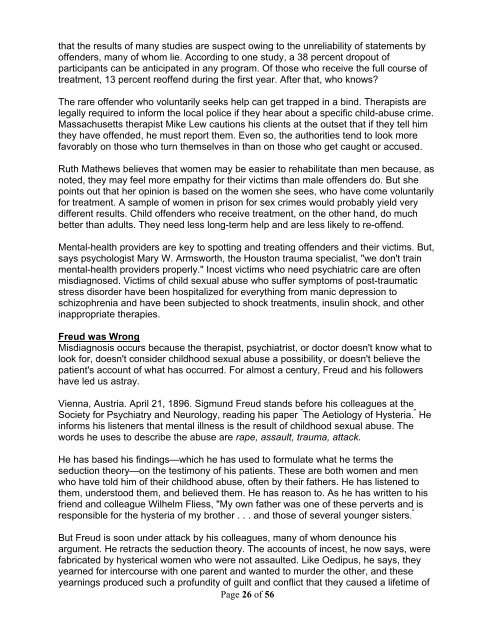Do you want to know what incest is? What it really is? No ...
Do you want to know what incest is? What it really is? No ...
Do you want to know what incest is? What it really is? No ...
Create successful ePaper yourself
Turn your PDF publications into a flip-book with our unique Google optimized e-Paper software.
that the results of many studies are suspect owing <strong>to</strong> the unreliabil<strong>it</strong>y of statements by<br />
offenders, many of whom lie. According <strong>to</strong> one study, a 38 percent dropout of<br />
participants can be anticipated in any program. Of those who receive the full course of<br />
treatment, 13 percent reoffend during the first year. After that, who <strong>know</strong>s?<br />
The rare offender who voluntarily seeks help can get trapped in a bind. Therap<strong>is</strong>ts are<br />
legally required <strong>to</strong> inform the local police if they hear about a specific child-abuse crime.<br />
Massachusetts therap<strong>is</strong>t Mike Lew cautions h<strong>is</strong> clients at the outset that if they tell him<br />
they have offended, he must report them. Even so, the author<strong>it</strong>ies tend <strong>to</strong> look more<br />
favorably on those who turn themselves in than on those who get caught or accused.<br />
Ruth Mathews believes that women may be easier <strong>to</strong> rehabil<strong>it</strong>ate than men because, as<br />
noted, they may feel more empathy for their victims than male offenders do. But she<br />
points out that her opinion <strong>is</strong> based on the women she sees, who have come voluntarily<br />
for treatment. A sample of women in pr<strong>is</strong>on for sex crimes would probably yield very<br />
different results. Child offenders who receive treatment, on the other hand, do much<br />
better than adults. They need less long-term help and are less likely <strong>to</strong> re-offend.<br />
Mental-health providers are key <strong>to</strong> spotting and treating offenders and their victims. But,<br />
says psycholog<strong>is</strong>t Mary W. Armsworth, the Hous<strong>to</strong>n trauma special<strong>is</strong>t, "we don't train<br />
mental-health providers properly." Incest victims who need psychiatric care are often<br />
m<strong>is</strong>diagnosed. Victims of child sexual abuse who suffer symp<strong>to</strong>ms of post-traumatic<br />
stress d<strong>is</strong>order have been hosp<strong>it</strong>alized for everything from manic depression <strong>to</strong><br />
schizophrenia and have been subjected <strong>to</strong> shock treatments, insulin shock, and other<br />
inappropriate therapies.<br />
Freud was Wrong<br />
M<strong>is</strong>diagnos<strong>is</strong> occurs because the therap<strong>is</strong>t, psychiatr<strong>is</strong>t, or doc<strong>to</strong>r doesn't <strong>know</strong> <strong>what</strong> <strong>to</strong><br />
look for, doesn't consider childhood sexual abuse a possibil<strong>it</strong>y, or doesn't believe the<br />
patient's account of <strong>what</strong> has occurred. For almost a century, Freud and h<strong>is</strong> followers<br />
have led us astray.<br />
Vienna, Austria. April 21, 1896. Sigmund Freud stands before h<strong>is</strong> colleagues at the<br />
Society for Psychiatry and Neurology, reading h<strong>is</strong> paper " The Aetiology of Hysteria. " He<br />
informs h<strong>is</strong> l<strong>is</strong>teners that mental illness <strong>is</strong> the result of childhood sexual abuse. The<br />
words he uses <strong>to</strong> describe the abuse are rape, assault, trauma, attack.<br />
He has based h<strong>is</strong> findings—which he has used <strong>to</strong> formulate <strong>what</strong> he terms the<br />
seduction theory—on the testimony of h<strong>is</strong> patients. These are both women and men<br />
who have <strong>to</strong>ld him of their childhood abuse, often by their fathers. He has l<strong>is</strong>tened <strong>to</strong><br />
them, unders<strong>to</strong>od them, and believed them. He has reason <strong>to</strong>. As he has wr<strong>it</strong>ten <strong>to</strong> h<strong>is</strong><br />
friend and colleague Wilhelm Fliess, "My own father was one of these perverts and <strong>is</strong><br />
responsible for the hysteria of my brother . . . and those of several <strong>you</strong>nger s<strong>is</strong>ters. "<br />
But Freud <strong>is</strong> soon under attack by h<strong>is</strong> colleagues, many of whom denounce h<strong>is</strong><br />
argument. He retracts the seduction theory. The accounts of <strong>incest</strong>, he now says, were<br />
fabricated by hysterical women who were not assaulted. Like Oedipus, he says, they<br />
yearned for intercourse w<strong>it</strong>h one parent and <strong>want</strong>ed <strong>to</strong> murder the other, and these<br />
yearnings produced such a profund<strong>it</strong>y of guilt and conflict that they caused a lifetime of<br />
Page 26 of 56


